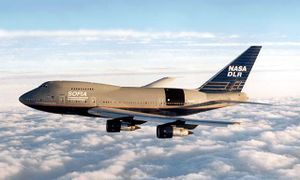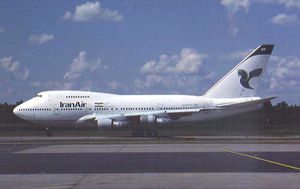PlaneSpottingWorld welcomes all new members! Please gives your ideas at the Terminal.
Boeing 747SP
| Boeing 747SP | |
|---|---|
| Syrian Boeing 747SP landing at Heathrow. | |
| Type | Airliner |
| Manufacturer | Boeing Commercial Airplanes |
| Designed by | Joe Sutter |
| Introduced | 1976 |
| Status | Discontinued, limited service |
| Primary users | Pan Am (10) United Airlines (10, from Pan Am) South African Airways (6) |
| Produced | 1976-1989 |
| Number built | 45 |
| Developed from | Boeing 747 |
The Boeing 747SP is a highly modified version of Boeing's Boeing 747-100 offering 'special performance'. Known during development as the 'short body' 747SB, the shortened fuselage permitted longer range flights to be made.
Contents
Background
The 747SP was first offered to customers in 1974, and the first airframe was delivered in 1976. A shorter derivative of the 747-100, the SP was developed to target two market requirements. The first addressed a need to compete with the DC-10 and L-1011 while maintaining commonality with larger 747s. The 747 was simply too big for many routes, and Boeing did not have a mid-sized widebody to compete in the segment of the market that the DC-10 and L-1011 had created. The second market requirement was the ultra long-range routes which were emerging in the mid-1970s. These routes needed not only longer range, but also higher cruising speeds. Boeing could not afford to develop an all-new design, instead shortening the 747 and re-optimized it for speed and range at the expense of capacity.
Development

Apart from having a significantly shorter fuselage and one fewer cabin door per side, the 747SP differs from other 747 variants in having simplified flaps and in having a taller vertical tail to counteract the decrease in moment-arm from the shortened fuselage. The 747SP uses larger single-piece flaps on the trailing edges rather than the triple-slotted flaps found on standard 747s. The SP was also the first Boeing widebody to have a wingspan measuring longer than the length of the plane; the other is the 777-200LR, which is only slightly wider than it is long. This is not standard design with airliners as it can make the aircraft center heavy if the wingspan is significantly longer. The SP, being 196 feet wide and 184 feet long, required a taller vertical fin because the shorter fuselage reduces the yaw moment arm.
The SP could accommodate 230 passengers in a comfortable 3-class cabin or 331 in a (303 economy, 28 business) 2-class cabin, and a maximum of 440 passengers in one class. Originally designated 747SB for "short body", it later was nicknamed "Sutter's balloon" by employees after 747 chief engineer Joe Sutter.[1] Boeing later changed the production designation to 747SP for "special performance", reflecting the aircraft's longer range and faster cruise speed. Pan Am was the launch customer for the 747SP, taking the first delivery, Clipper Freedom, on March 5 1976.[2]
The 747SP was the longest-range airliner available until the 747-400 entered service in 1989. For all its technical achievements, the SP never sold as well as Boeing hoped. Increased fuel prices in the mid 70's to early 80's, its heavy wingspan, reduced capacity, and increased range of forthcoming new planes were some of the many factors that contributed to its low sales. Only 45 were ever built and most that are still in service are used by operators in the Middle East. The production run of the SP ran from 1976 to 1983, however a VIP order for Amiri Flight of UAE forced Boeing to open production of the SP one last time in 1989. This plane is meticulously kept and has been photographed numerous times around the world. Another special 747SP is the SOFIA infrared astronomical observatory, where the airframe was modified to carry a 2.5-meter-diameter infrared reflecting telescope to high altitude, above most of the infrared-absorbing water vapor in the atmosphere. Originally delivered to Pan Am and titled "Clipper Lindbergh", NASA has the name displayed in Pan Am script on the plane.
Operators
Forty-five 747SP aircraft were built between 1974 and 1989. 14 are still flying as of August, 2006, 15 have been scrapped, and the remainder are in storage or awaiting salvage.[3]
Active service
- VIP Amiri Flight of UAE
- VIP Government of Yemen
- VIP Government of Qatar
- VIP Government of Iran
- VIP Government of Saudi Arabia
- SOFIA Astronomical Observatory
- Iran Air (in passenger operation)
- Syrian Arab Airlines (in passenger operation)
Former customers
- Pan Am took delivery of ten 747-SP21 aircraft between 1976 and 1979, operating them on trans-Pacific routes to Asia and Oceania. The aircraft and routes were sold to United Airlines in 1986, and remained in operation until 1994.
- South African Airways operated six 747-SP44 aircraft on flights from Johannesburg to London, during the apartheid years, when that airline's aircraft were not allowed to fly over African countries and had to fly around the Bulge of Africa. The extra range allowed the aircraft to cover the additional distance. The sole remaining South African Airways 747SP - the "Maluti" - was decommissioned on 30 September 2006 with a final flight to Rand Airport where it will remain on show as a static display/museum aircraft. (This final transport flight was the aircraft's first flight in three years.)
- TWA operated three 747-SP31 aircraft from 1979 to 1986. Two of these were purchased by American Airlines and used on London and Tokyo routes until 1993.
- Iran Air took delivery of four 747-SP86 aircraft between 1976 and 1978. Prior to the 1979 Islamic revolution, the aircraft were used on the daily Tehran-New York flight, at the time the longest non-stop airline route in the world. Two of those four are still in service at 2006.
- Qantas operated two 747-SP38 aircraft from 1980 to 2004. In particular, these aircraft were originally used for flights between Sydney and Wellington, due to the latter's short runway but still able to meet passenger number requirements. [1]
- Braniff took delivery of 3 747-SP on their ultra longhaul routes in the Pacific. Fitted with 300 seats in a luxurious cabin and an all orange exterior, it was easily recognized by onlookers and plane enthusiasts.31 Of the three planes, as of August 2006, one has been scrapped, one is in VIP service with Yemen government, and the other is in VIP service with the Oman government.
- Aerolineas Argentinas operated one SP (from Braniff) on flights to Miami, Los Angeles, Toronto, Zürich and Frankfurt.
Records
The SP made an ideal aircraft for record-setting flights. There were 3 significant commercial record-setting flights flown by 747SP, two operated by Pan Am and the other operated by United Airlines with the aircraft being 'loaned' to Friendship Foundation, in order to raise money for the foundation. Those flights are:
- Liberty Bell Express—From May 1 to May 3, 1976. 2 stopovers at Indira Gandhi International Airport of New Delhi and Tokyo-Haneda Airport.
- Pan Am Flight 50—to celebrate the 50th anniversary of Pan Am. Flown during late-October, 1977, with the time duration of 54 hours, 7 minutes, 12 seconds. 3 stopover at London-Heathrow Airport, Cape Town International Airport and Auckland Airport.
- Friendship One—Flown in early 1988, to raise funds for Friendship Foundation. 2 stopovers at Athens Airport and Taipei-Taiwan Taoyuan International Airport, (formerly the Chiang Kai-shek International Airport). Record lasted less than a month.
Incidents and accidents
- On February 19, 1985 a China Airlines Boeing 747SP-09 (registration N-4522V) with 274 passengers and crew onboard on a flight from Chiang Kai-shek Airport to Los Angeles International Airport suffered an inflight failure on the number four engine. While the flight crew attempted to restore power the aircraft rolled to the right and started a steep descent from the cruising altitude of 41,000 feet, accelerating to 4.8 G and 5.1 G on two occasions. The captain managed to stabilize the aircraft at 9,500 feet and the aircraft diverted to San Francisco International Airport which was 550 km (343.8 mls) away. Two passengers were seriously injured and the aircraft suffered major structural damage.[4]
- On October 5, 1998 a Linhas Aéreas de Moçambique Boeing 747SP-44 (registration ZS-SPF) with 66 passengers and crew onboard on a flight from Maputo International Airport to Lisboa Airport suffered a uncontained failure of the number three engine during initial climb. The failing engine sent debris into the number four engine and to the wing of the aircraft, causing a fire. The aircraft was able to return to the airport and no passengers were killed, but the aircraft was written off.[5]
- On January 15, 2004 a Iran Air Boeing 747SP-86 (registration EP-IAC) with 180 passengers and crew onboard suffered hydraulic problems after departure from Beijing Capital International Airport, China. The aircraft returned to the airport, but the nosegear collapsed upon landing. The aircraft was ferried back to Tehran where it was withdrawn from service.[6]
Specifications (747SP)
Data from Boeing Commercial Airplanes[7] and Airliners.net[8]
General characteristics
- Crew: 3 (2 pilots, flight engineer)
- Capacity: 331 (28 first, 303 economy)
- Length: 184 ft 9 in (56.31 m)
- Wingspan: 195 ft 8 in (59.64 m)
- Height: 65 ft 10 in (20.06 m)
- Wing area: 5,500 ft² (511 m²)
- Empty weight: 336,870 lb (152,780 kg)
- Max takeoff weight: 670,000 lb (304,000 kg)
- Powerplant: 4× Rolls-Royce RB211-524C2 turbofan engines, 46,500 lbf (206.8 kN) each
Performance
- Maximum speed: .92 Mach (591 knots, 1,095 km/h)
- Cruise speed: .88 Mach (535 knots, 990 km/h)
- Range: 6,650 nm (7,650 mi, 12,325 km) with 276 passengers
References
- ↑ Sutter, Joe (2006). 747: Creating the world's first jumbo jet and other adventures from a life in aviation. HarperCollins, p. 218. ISBN 0-06-088241-7.
- ↑ Norris, Guy (1997). Boeing 747: Design and Development Since 1969. Motorbooks International, p. 74. ISBN 0-7603-0280-4.
- ↑ Boeing 747SP Website - Productionlist. 747SP.com. Retrieved on 2006-10-10.
- ↑ Aviation Safety Network report - 19 February 1985 accident
- ↑ Aviation Safety Network report - 5 October 1998 accident
- ↑ Aviation Safety Network report - 15 January 2004 accident
- ↑ 747 Airplane Characteristics for Airport Planning. Boeing Commercial Airplanes. Retrieved on 2006-10-09.
- ↑ Boeing 747SP. Airliners.net. Retrieved on 2006-10-09.
External links
Related content
Related development
Comparable aircraft
Designation sequence
| 747 | - 757 - 767 - 7J7 | |
| 747LCF | ||
| 747SP |
Related lists
See also
Boeing airliners | |
|---|---|
| Piston-engined | |
| Jet-engined | |
| In development | |
| Proposed | |
| Not developed | 2707 · 7J7 · NLA · Sonic Cruiser |
Giant aircraft | |
|---|---|
| Production | |
| Prototypes | |
| Concepts | Proposed: Airbus A380-900 · Reaction Engines A2 · Beriev Be-2500 · Boeing 747-8 · Abandoned: Boeing New Large Airplane · Boeing Pelican · McDonnell Douglas MD-12 |
| Wingless aircraft | Biggest airship: Luftschiffbau Zeppelin Hindenburg class · Biggest blimp: Goodyear ZPG-3W · Biggest helicopter: Mil Mi-12 |
Lists relating to aviation | |
|---|---|
| General | Timeline of aviation · Aircraft · Aircraft manufacturers · Aircraft engines · Aircraft engine manufacturers · Airports · Airlines |
| Military | Air forces · Aircraft weapons · Missiles · Unmanned aerial vehicles (UAVs) · Experimental aircraft |
| Notable incidents and accidents | Military aviation · Airliners · General aviation · Famous aviation-related deaths |
| Records | Flight airspeed record · Flight distance record · Flight altitude record · Flight endurance record · Most produced aircraft |


